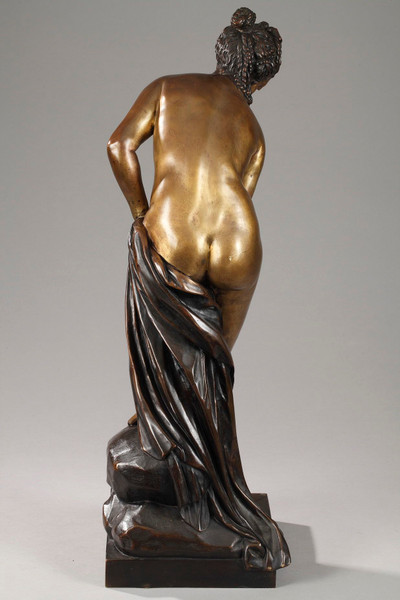A bronze sculpture with a brown and gold patina, after "Venus Emerging from the Bath," also known as "The Bather," by Gabriel-Christophe Allégrain (Paris, 1710-1795). The original marble version, in the Neoclassical style, was commissioned in 1755 by the Marquis de Marigny (1727-1781), Director General of the King's Buildings, for his château at Choisy-le-Roi. The plaster model was exhibited at the Salon of 1757, and the marble statue at the Salon of 1767, where it was noticed by Denis Diderot, who left a famous comment: "Beautiful, beautiful, sublime figure; they even say the most beautiful, the most perfect figure that modern artists have ever created [...] The beautiful shoulders, how beautiful they are, how plump that back is, what a shape for the arms, what precious, what miraculous truths of nature in all those parts." This was the sculptor's first major commission. Allegrain drew significant inspiration from a small bronze by the Mannerist sculptor Jean de Bologne, "Bather Resting Her Foot on a Perfume Vase," adopting the sinuous lines of the body, the sloping shoulders, the high chest, and the hairstyle composed of sophisticated braids. The sculpture was acquired by Louis XV, who presented it on April 12, 1772, to his favorite, Countess Du Barry (1743-1793), who installed it in the park of her Château de Louveciennes. The original is currently held at the Louvre Museum. This bronze edition was produced in the 19th century by the Parisian bronze foundry Graux-Marly Frères (marked in relief on the base: GRAUX-MARLY FRERES / PARIS). The Graux-Marly firm, founded in 1845, was located at 8 rue du Parc Royal in 1862. It produced sculptures and furnishings. It won a bronze medal at the National Exhibition of Industrial Products in 1849 and a first-class medal at the Universal Exhibition of 1855. It was dissolved in May 1890.
- Reference :
- 1732
- Availability :
- Sold
- Width :
- 19 (cm)
- Height :
- 59 (cm)
- Depth :
- 20 (cm)
- Identify Exists:
- False
























